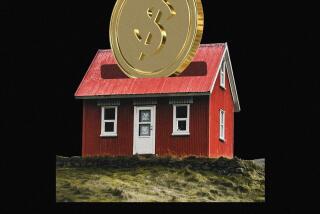Household Debt Grows Precarious as Rates Increase
The upward creep of interest rates has become a growing burden to American families, as more are straining under record debt loads amassed in a spending binge powered by the booming economy.
Families are overextending themselves as never before, as indicated recently when total household debts--including mortage loans--surpassed total after-tax incomes for the first time in history.
And debt burdens continue to rise, notably for lower-income families. Credit card debt particularly has grown sharply in recent years, and banks are now hiking rates on those cards, leaving some consumers hurting.
“It really does indicate that there’s a soft underbelly in the economy,” said Mark Zandi, an economist at RFA Dismal Sciences, referring especially to lower-income households. “And that soft underbelly will be exposed the higher interest rates go.”
Household debt service--or interest and principal payments as a share of take-home pay--rose to 13.5% in the fourth quarter of 1999. While considered high, that percentage is still lower than the peak of 14.2% in late 1986.
But the figure masks the hardships faced by lower-income households, which have been the most aggressive borrowers recently, as lenders have been liberally extending credit. And signs of trouble are emerging.
Last year, FHA home loans that were delinquent by more than 30 days rose to a high of 8.6%. And delinquencies are also rising on the so-called sub-prime loans, made largely to poor-credit households, as well as other higher-risk equity loans.
And interest rates will probably move even higher after the Federal Reserve Board likely raises the key short-term interest rate Tuesday, probably by a sizable half-point, to 6.5%. The Fed is trying to slow the giddy spending by consumers, which has fueled the nation’s sizzling economic growth but is now kindling inflation.
“The Fed has every intention of trying to squeeze, especially consumers who are overburdened with debt,” said Peter Kretzmer, a senior economist at Bank of America. “The idea here is to slow down consumers enough so that larger interest rate increases aren’t necessary later on, the kind that could cause defaults to rise and the economy to go into recession. In short, a little pain now saves greater pain later on.”
Stacy Ybarra, 27, is among those worried about the Federal Reserve’s widely expected move to boost short-term interest rates again next week.
The Ybarra family of five in Huntington Beach has been racking up debts in a perilous pattern of spending that reaches into virtually all areas of their lives. “We charge everything, pretty much,” said Ybarra, who works as a loan officer.
Their credit card balances exceed $45,000, and with each successive interest rate hike--the Fed has raised rates five times since last June--their debt burden is like walls closing in on them. Now the Ybarras see belt-tightening ahead: Their boys will have to make do with old baseball uniforms. “No Chuck E. Cheese every Friday night,” he said.
Not all economists would agree that consumer debt loads are worrisome. Personal bankruptcies have been declining, incomes are growing, and many households have taken advantage of the long bull stock market and rising home prices to lower their credit card debts.
“If you look at household debt in relation to households’ ability to pay off that debt, things don’t look that bad,” said Manuel Ramirez, an economist with the Wall Street firm Morgan Stanley Dean Witter.
But there are some early indications of slowing economic growth. And the biggest fear is what will happen to many families loaded with debt if the economy falters and jobs disappear--a scenario that would certainly drive up bankruptcies and foreclosures.
For now, rising interest rates mean many people will be paying more in credit card payments and mortgages. This week, the average rate on a 30-year mortgage jumped to a five-year high of 8.52%. It will cost more to borrow money as well. The average interest rate on a home equity loan is now 10.01%, compared to 9.09% a year ago.
In a national Times Poll taken last week, 84% of respondents described the economy as doing “fairly well” or “very well.” At the same time, 27% of those said their personal finances were “shaky.” And nearly four out of 10 respondents reported some or much difficulty paying installment loans, car payments and insurance premiums.
Of those with household incomes less than $20,000, 57% reported having difficulty with debts.
Shawna Lee, a 38-year-old grocery worker in Missouri who was polled, said in a follow-up interview that she is suffocating under doctor and hospital debts that she built up when she had no health insurance.
The bills have been turned over to collection agencies that are, or soon will be, tacking on interest, said Lee, who made $10,700 last year. She fears the interest rate will be bumped up, forcing her to give up necessities.
“Air conditioning?” she said. “I can’t even afford cable TV, not even just basic cable. It won’t fit into my budget.”
According to the Federal Reserve Board’s survey released earlier this year, one out of every five households with incomes less than $50,000 had debt service burdens greater than 40%, which is considered high. By comparison, in each of the last three previous surveys, covering 1989 to 1995, about 15% of such households were weighed down with that much debt burden.
Richard Pittman, director of counseling and housing for Consumer Credit Counseling Service of Los Angeles, says he worries about rising delinquencies among homeowners.
“This is an area where I expect us to start seeing some real misery with the next [interest rate] increases,” he said. The number of clients counseled by Pittman’s L.A. area offices has been declining, but the average debt load of families visiting the center jumped to about $23,000 in 1999, a nearly 15% increase.
“It’s primarily credit cards,” said Marcus Tiggs, a bankruptcy attorney in Los Angeles. “The major complaint, hands down, is the interest rates. I hear it all the time: ‘Marcus, the interest rate is killing me.’ ”
The typical amount of credit card debt carried by households that don’t pay off their bills each month rose to a projected $7,564 last year, up 5% from the year before, according to CardWeb.com, a Maryland firm that tracks credit card trends. The average interest rate paid on credit card debt rose to 17.99% last year, compared to $17.75% in 1998. But interest rates are likely to rise in the coming months.
Junior high school teacher Lupe Casillas, who makes about $38,000 a year, admits that she usually pays just the minimum on her four credit cards. And her balance has ballooned to $10,000.
If rates keep rising--hers now average about 20%--the 30-year-old Downey resident said she’ll have to buy fewer clothes and cut back on meals out. Casillas looks wistful when she talks about the small pleasures she might have to forgo, like a glass of wine with dinner.
“It’s that bottle of wine that you just can’t buy,” she said.
But for others, it’s the necessities they will have to give up.
George Simental, a 24-year-old maintenance worker who makes $8 an hour, began collecting credit cards when he was 17. He now has eight cards with balances totaling $5,000 and an average interest rate of about 20%.
“I was more like a shop-a-holic,” the Buena Park resident said, describing his pattern of spending. “I was just buying clothes. I didn’t even need them. I was worse than my sisters.”
Now Simental worries about being hounded by credit card collection agencies. If he can keep his job and things go well, he figures he can pay off the $5,000 in about two years.
“I just want to get free of debt,” he said.
(BEGIN TEXT OF INFOBOX / INFOGRAPHIC)
Under Strain
Debt burdens have been rising for all U.S. households but most sharply for families with lower incomes.
Share of U.S. Families With High Debt Service*
1989
incomes under $50,000: 15.4%
incomes over $50,000: 4%
total: 10.1%
*
1992
incomes under $50,000: 15.7%
incomes over $50,000: 3.8%
total: 10.9%
*
1995
incomes under $50,000: 15.4%
incomes over $50,000: 3.5%
total: 10.5%
*
1998
incomes under $50,000: 19.5%
incomes over $50,000: 4.8%
total: 12.7%
*High debt service refers to those whose interest and principal payments make up more than 40% of their after-tax income
Source: Federal Reserve Survey of Consumer Finance
More to Read
Inside the business of entertainment
The Wide Shot brings you news, analysis and insights on everything from streaming wars to production — and what it all means for the future.
You may occasionally receive promotional content from the Los Angeles Times.










